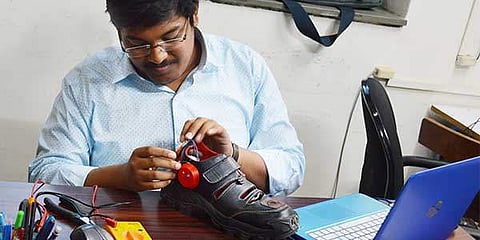

W alking around is one of the toughest things for a visually challenged person. Even when they're using a cane. To help them get past this, young innovator Krishna Sai Inkoolu, from Anakapalli in Visakhapatnam invented 'Taparch Footwear', which helps them walk sans the stick. This 24-year-old who studied Industrial Engineering at Gitam University designed a mechanism with an embedded electronic circuit that senses the existence of obstacles in the path and communicates it to the visually challenged person with a 'tap', while they're walking — helping them stay safe.
And that's how the shoes came to be. "Since the initial stages, I always focussed on proving that my concept would change the lives of the visually challenged, rather than concentrating on the final design and manufacturing.
Till 2015, I tried many experiments and had been to many places to make a trial on my concept. Sometimes I brought a few persons to my campus and made them walk wearing those shoes," says Krishna.
"The sensor detects the presence of any obstacle in front of the shoe and alerts the user by giving a tap. The sensor is placed at the weld point of the shoe, which identifies the obstacle and gives a tap on the arch of the shoe.
The entire circuit is placed in the shoe socket, which has a connection with the weld point where the sensor is placed and transmits and receives the signal, carrying the obstacle's distance and dimension information. This is connected to a mechanical device which taps the arch of the foot. It is self-sustaining as it harvests the human mechanical energy while walking, resulting in power conservation," he explains about Taparch.
When asked if there was a failsafe, just in case it stopped working while in transit, he says "No product is 100 per cent foolproof. The shoe is embedded with a mistake-proofing device to detect any errors, if the sensor fails, an alarm sounds to alert the wearer." After he applied for incubation in 2015, Taparch was one of the five companies shortlisted. He was supported by the National Institute of Design, Ahmedabad with design consultancy.
"By the time we reached NID in March 2016, we had completed the technology but then the design aspect had a few kinks. So, they have suggested that they make it like a normal sandal," said Krishna. "Since the technology is proven, we are now searching for footwear suppliers for manufacture. In that case we have to have got the component from different companies, we need to finalise it and launch the product in the mid of December," he said.
"What makes me more satisfied is, while testing it on the visually challenged people of Blind People Association (BPA) Ahmedabad, they were curious to explore the world wearing this footwear. My aim is to set up an innovation centre in AP, where they would be plenty of opportunities for the youngsters who can come and work. In fact I would also engage the visually challenged as a part of my incubator," says Krishna.